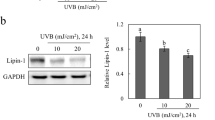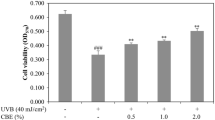Abstract
Skin is usually exposed to adverse environmental conditions that may cause pathological cell proliferation and malignant transformation. Antioxidants are able to affect these processes and eliminate transformed cells. The purpose of this work was to investigate the effect of α-lipoic acid (ALA) on human epidermoid carcinoma cell line A431. It was found that 100, 200, 300, 500 μM ALA added for 24, 48, 72 h inhibited cell proliferation and stimulated apoptosis. Most dying cells have abnormal nuclei (micronuclei, giant nuclei, nuclei with buds). Electron microscopy showed that cells with normal nuclear phenotypes after treatment with 200 μM ALA for 48 h had ultrastructural organizations typical for control cells. Thus, α-ALA not only triggers the apoptosis of carcinoma cells, but it may also activate the mechanism for eliminating cells with abnormal numbers of chromosomes.
Similar content being viewed by others
Abbreviations
- AI:
-
apoptocic index
- ROS:
-
reactive oxygen species
- ALA:
-
[alpha]-lipoic acid
- MI:
-
mitotic index
References
Agarwal, M.L., Taylor, W.R., Chernov, M.V., Chernova, O.B., and George, R. Stark, G.R., The p53 Network., J. Biol. Chem., 1998, vol. 273, pp. 1–4.
Bilska, L. and Wtodek, L., Lipoic Acid—the Drug or the Future? Pharm. Reports, 2005, vol. 57, pp. 570–577.
Brash, D.E. and Havre, P.A., New Careers for Antioxidants, Proc. Natl. Acad. Sci. USA, 2002, vol. 99, pp. 13969–13971.
Byun, C.H., Koh, J.M., Kim, D.K., Park, S.I., Lee, K.U., and Kim, G.S., Alpha-Lipoic Acid Inhibits TNF-AlphaInduced Apoptosis in Human Bone Marrow Stromal Cells., J. Bone Miner Res., 2005, vol. 20, pp. 1125–1135.
Cakatay, U., Pro-Oxidant Actions of Alpha-Lipoic Acid and Dihydrolipoic Acid. Med. Hypotheses, 2006, vol. 66, no. 1, pp. 110–117.
Chesnokova, N.P., Ponukalina, E.V., and Bizenkova, M.N., General Characteristic of the Sources of Generation of Free Radicals and Antioxidant Systems. Advances in Modern Natural Science, Med. Nauki, 2006, vol. 7, pp. 37–41.
Dovinova, I., Novotny, L., Rauko, P., and Kvasnicka, P., Combined Effect of Lipoic Acid and Doxorubicin in Murine Leukemia, Neoplasma, 1999, vol. 46, pp. 237–241.
Droge, W., Free Radicals in the Physiological Control of Cell Function, Physiol. Rev., 2001, vol. 82, pp. 47–95.
Fenech, M., The Cytokinesis-Block Micronucleus Technique and Its Application to Genotoxicity Studies in Human Populations, Env. Health Perspect. Suppl., 1994, vol. 101, pp. 101–107.
Grady, W.M., Genomic Instability and Colon Cancer, Cancer Metastasis Rev., 2004, vol. 23, pp. 11–27.
Guan, Z., Wang, X.R., Zhu, X.F., Huang, X.F., Xu, J., Wang, L.H., Wan, X.B., Long, Z.J., Liu, J.N., Feng, G.K., Huang, W., Zeng, Y.X., Chen, F.J., and Liu, Q., Aurora-a, a Negative Prognostic Marker, Increases Migration and Decreases Radiosensitivity in Cancer Cells, Cancer Res., 2007, vol. 67, pp. 10 436–10 444.
Haupt, S., Berger, M., Goldberg, Z., and Haupt, Y., Apoptosis—the p53 Network, J. Cell Sci., 2003, vol. 116, pp. 4077–4085.
Hultberg, M. and Hultberg, B., The Effect of Different Antioxidants on Glutathione Turnover in Human Cell Lines and Their Interaction with Hydrogen Peroxide, Chem. Biol. Interac., 2006, vol. 163, pp. 192–198.
Hupp, T.R., Sparks, A., and Lane, D.P., Small Peptides Activate the Latent Sequence-Specific DNA Binding Function of p53, Cell, 1995, vol. 83, pp. 237–245.
Jimenez, G.S., Khan, S.H., Stommel, J.M., and Wahl, G.M., P53 Regulation by Post-Translational Modification and Nuclear Retention in Response to Diverse Stresses, Oncogene, 1999, vol. 18, pp. 7656–7665.
Kim, A.L., Athar, M., Bickers, D.R., and Gautier, J.J., Ultraviolet-B-Induced G1 Arrest Is Mediated by Downregulation of Cyclin-Dependent Kinase 4 in Transformed Keratinocytes Lacking Functional p53, Invest. Dermatol., 2002, vol. 118, pp. 818–824.
Kisurina-Evgeneva, O.P., Bryantseva, S.A., Shtil, A.A., and Schnischenko, G.E., Antitubulin Agents Can Initiate Different Apoptotic Pathways, Biofizika, 2006, vol. 51, no. 5, pp. 875–879.
Kurose, A., Sasaki, K., Ishida, Y., Shibata, Y., Yanagisawa, S., Kanno, C., Uesugi, N., Wada, T., and Miura, Y., Flow Cytometric Analysis of p53 Expression during the Cell Cycle, Oncology, 1995, vol. 52, pp. 123–127.
Kwok, T.T., Mok, C.H., and Menton-Brennan, L., Up-Regulation of a Mutant Form of p53 by Doxorubicin in Human Squamous Carcinoma Cells, Cancer Res., 1994, vol. 54, pp. 2834–2836.
Lange, B.M., Integration of the Centrosome in Cell Cycle Control. Stress Response and Signal Transduction Pathways, Curr. Opin. Cell Biol., 2002, vol. 14, no. 1, pp. 35–43.
Levy, E.J., Anderson, M.E., and Meister, A., Transport of Glutathione Diethyl Ester into Human Cells, Proc. Natl. Acad. Sci. USA, 1993, vol. 90, pp. 9171–9175.
Marsh, S.A., Laursen, P.B., Pat, B.K., Gobe, G.C., and Coombes, J.S., Bcl-2 in Endothelial Cells Is Increased by Vitamin E and Alpha-Lipoic Acid Supplementation but not Exercise Training, J. Mol. Cell Cardiol., 2005, vol. 38, pp. 445–451.
Moll, U.M., Wolff, S., Speidel, D., and Deppert, W., Transcription-Independent Proapoptotic Functions of p53, Curr. Opin. Cell Biol., 2005, vol. 17, pp. 631–636.
Moungjaroen, J., Nimmannit, U., Callery, P.S., Wang, L., Azad, N., Lipipun, V., Chanvorachote, P., and Rojanasakul, Y., Reactive Oxygen Species Mediate Caspase Activation and Apoptosis Induced by Lipoic Acid in Human Lung Epithelial Cancer Cells through Bcl-2 Down-Regulation, J. Pharmacol. Exp. Ther., 2006, vol. 319, pp. 1062–1069.
Nagai, H., Noguchi, T., Takeda, K., and Ichijo, H., Pathophysiological Roles of ASKI-MAP Kinase Signaling Pathways, J. Biochem. Mol. Biol., 2007, vol. 40, pp. 1–6.
Nakano, H., Nakajima, A., Sakin-Komazawa, S., Piao, J.H., Xue, X., and Okumura, K., Reactive Oxygen Species Mediate Crosstalk between NF-jB and JNKf, Cell Death Differ., 2006, vol. 13, pp. 730–737.
Oda-Sato, E. and Tanaka, N., Abnormal Centrosome Amplification and Aurora-A Activation in p53-Deficient Cells, J. Nippon Med. Sch., 2007, vol. 74, pp. 384–385.
Pan, M.H., Sin, Y.H., Lai, C.S., Wang, Y.J., Lin, J.K., Wang, M., and Ho, C.T., Induction of Apoptosis by 1-(2Hydroxy-5-Methylphenyl)-3-Phenyl-1,3-Propanedione through Reactive Oxygen Species Production, Gadd153 Expression, and Caspases Activation in Human Epidermoid Carcinoma Cells, J. Agric. Food Chem., 2005, vol. 53, pp. 9039–9049.
Papa, S., Bubici, C., Zazzeroni, F., Pham, C.G., Kuntzen, C., Knabb, J.R., Dean, K., and Franzoso, G., The NF-jB-Mediated Control of the JNK Cascade in the Antagonism of Programmed Cell Death in Health and Disease, Cell Death Differ., 2006, vol. 13, pp. 712–729.
Park, D.J., Nakamura, H., Chumakov, A.M., Said, J.W., Miller, C.W., Chen, D.L., and Koeffler, H.P., Transactivational and DNA Binding Abilities of Endogenous p53 in p53 Mutant Cell Lines, Oncogene, 1994, vol. 9, pp. 1899–1906.
Pias, E.K. and Aw, T.Y., Apoptosis in Mitotic Competent Undifferentiated Cells Is Induced by Cellular Redox Imbalance Independent of Reactive Oxygen Species Production, Faseb J., 2002, vol. 16, pp. 781–790.
Prahalathan, C., Selvakumar, E., Varalakshmi, P., Kumarasamy, P., and Saravanan, R., Salubrious Effects of Lipoic Acid Against Adriamycin-Induced Clatogenesis and Apoptosis in Wistar Rat Bone Marrow Cells, Toxicology, 2006, vol. 222, pp. 225–232.
Qanungo, S., Wang, M., and Nieminen, A.L., N-Acetyl-L-Cysteine Enhances Apoptosis Through Inhibition of Nuclear Factor-Kappa b in Hypoxic Murine Embryonic Fobroblasts., J. Biol. Chem., 2004, vol. 279, pp. 50 455–50 464.
Rajagopalan, H. and Lengauer, C., Aneuploidy and Cancer, Nature, 2004, vol. 432, pp. 338–341.
Scian, M.J., Stagliano, K.E., Ellis, M.A., Hassan, S., Bowman, M., Miles, M.F., Deb, S.P., and Deb, S., Modulation of Gene Expression by Tumor-Derived p53, Mutants Cancer Res., 2004, vol. 64, pp. 7447–7454.
Seo, Y.R., Fishel, M.L., Amundson, S., Kelley, M.R., and Smith, M.L., Implication of p53 in Base Excision DNA Repair: in Vivo Evidence, Oncogene, 2002, vol. 21, pp. 731–737.
Simbula, G., Columbano, A., Ledda-Columbano, G.M., Sanna, L., Deidda, M., Diana, A., and Pibiri, M., Increased ROS Generation and p53 Activation in α-Lipoic AcidInduced Apoptosis of Hepatoma Cells, Apoptosis, 2007, vol. 12, pp. 113–123.
Thannickal, V.J. and Fanburg, B.L., Reactive Oxygen Species in Cell Signaling, Am., J. Physiol. Lung Cell Mol. Physiol., 2000, vol. 279, pp. 1005L–1028L.
Valko, M., Rhodes, C.J., Moncol., J., Izakovic, M., and Mazur, M., Free Radicals, Metals and Antioxidants in Oxidative Stress-Induced Cancer, Chem. Biol Interact., 2006, vol. 160, pp. 1–40.
Van de Mark, K., Chen, J.S., Steliou, K., Perrine, S.P., and Faller, D.V., α-Lipoic Aid Induces P27Kip-Dependent Cell Cycle Arrest in Non-Transformed Cell Lines and Apoptosis in Tumor Cell Lines., J. Cell. Physiol., 2003, vol. 194, pp. 325–340.
Van Schooten, F.J., Nia, A.B., De Flora, S., D’Agostini, F., Izzotti, A., Camoirano, A., Balm, A.J.M., Dallinga, J.W., Bast, A., Haenen, G.R.M.M., Van’t Veer, L., Baas, P., Sakai, H., and Van Zandwijk, N., Effects of Oral Administration of N-Acetyl-L-Cysteine: A Multi-Biomarker Study in Smokers, Cancer Epidemiol. Biomarkers Prev., 2002, vol. 11, pp. 167–175.
Weaver, B.A. and Cleveland, D.W., Does Aneuploidy Cause Cancer?, Curr. Opin. Cell Biol., 2006, vol. 18, pp. 658–667.
Weinmann, L., Wischhusen, J., Demma, M.J., Naumann, U., Roth, P., Dasmahapatra, B., and Weller, M., A Novel p53 Rescue Compound Induces p53-Dependent Growth Arrest and Sensitizes Glioma Cells to Apo2L/TrailInduced Apoptosis, Cell Death Differ., 2008, vol. 15, pp. 718–729.
Wenzel, U., Nuclek, A., and Daniel, H., Alpha-Lipoic Acid Induces Apoptosis in Human Colon Cancer Cells by Increasing Mitochondrial Respiration with a Concomitant O2-Generation, Apoptosis, 2005, vol. 10, pp. 359–368.
Wong, R.P., Tsang, W.P., Chau, P.Y., Co, N.N., Tsant, T.Y., and Kwok, T.T., P53-R273H Gains New Function in Induction of Drug Resistance Through down-Regulation of Procaspase-3, Mol. Cancer Ther., 2007, vol. 6, pp. 1054–1061.
You, H., Yu, W., Sanders, B.G., and Kline, K., Rrr-α-Tocopheryl Succinate Induces Mda-Mb-435 and Mcf-7 Human Breast Cancer Cells to Undergo Differentiation, Cell Growth Differ., 2001, vol. 12, pp. 471–480.
Zhang, W.J., Wei, H., Hagen, T., and Frei, B., α-Lipoic Acid Attenuates LPS-Induced Inflammatory Responses by Activating the Phosphoinositide 3-Kinase/Akt Signaling Pathway, Proc. Natl. Acad. Sci. USA, 2007, vol. 104, pp. 4077–4082.
Author information
Authors and Affiliations
Corresponding author
Additional information
Original Russian Text © O.P. Kisurina-Evgenieva, G.E. Onishchenko, 2010, published in Tsitologiya, Vol. 52, No. 3, 2010, pp. 225–234.
Rights and permissions
About this article
Cite this article
Kisurina-Evgenieva, O.P., Onishchenko, G.E. Elimination of cells with abnormal nuclei in human epidermoid carcinoma cell line A431 by α-lipoic acid. Cell Tiss. Biol. 4, 177–184 (2010). https://doi.org/10.1134/S1990519X10020070
Received:
Published:
Issue Date:
DOI: https://doi.org/10.1134/S1990519X10020070




